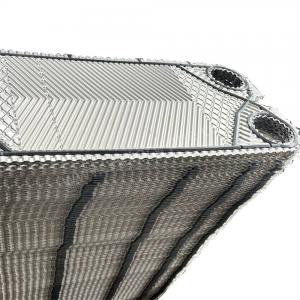Product Details
Product Description
GEA VT04/VT10/VT20/VT40/VT80/VT405/VT2508 Relplacement Plate Heat
Exchanger Plates
GEA Heat Exchanger Plates
Heat exchanger plates are used in various applications such as
cooling and heating processes in industries like HVAC systems,
refrigeration, power plants, chemical processing, food and beverage
production, and many others.Heat exchanger plates are essential for transferring heat between two fluids efficiently
while keeping them separate to prevent mixing. Heat exchanger
plates play a crucial role in maintaining temperature control and
energy efficiency in many industrial processes.
Heat exchanger plates are the most important part of plate heat
exchanger. Heat exchanger plates work by allowing two fluids to
flow on either side of the plates in separate channels. Heat is
transferred from one fluid to the other through the thin plates,
without the fluids mixing. As the hot fluid passes through one set
of plates, it transfers its heat to the colder fluid flowing
through the adjacent set of plates. This transfer of heat occurs
due to the close proximity of the fluids separated by the plates,
maximizing the surface area for heat exchange. The design of the
plates and flow arrangement optimize heat transfer efficiency in
the heat exchanger.
| Brand | Model |
| GEA | VT04,VT10,VT20,VT40,VT80,VT405,VT2508,N40,FA184,NT50,NT100T,NT100M NT100X,NT150S,NT150L,NT250S,NT250M,NT250L,NT350S, NT350M,NT500 |
| Material | Specification |
| Stainless Steel | SUS304 316 316L 310S 904 |
| Titanium and titanium-palladium alloy | TAi TAi-Pd |
| Hastelloy | C276 D205 B2G |
| Nickel | Ni200 Ni201 |
| Molybdenum | 254 |
Applacations
| Plate material | Suitable for fluids |
| Stainless steel (SUS304.316, etc.) | Purified water, river water, edible oil, mineral oil |
| Titanium and titanium palladium (Ti, Ti-Pd) | Sea water, salt water, salt compounds |
| 20Cr,18Ni,6Mo(254SMO) | Dilute sulfuric acid, dilute salt aqueous solution, inorganic
aqueous solution |
| Nickel (Ni) | High temperature, high concentration caustic soda |
| HASTELLOY alloy (C276, D205, B2G) | Concentrated sulfuric acid, hydrochloric acid, phosphoric acid |
Heat exchanger plate Choose:
- The choice of plate types and corrugation patterns for heat
exchangers plate should be based on the specific heat transfer conditions and
requirements. In situations where there is a large flow rate and a
small allowable pressure drop, plates with low resistance should be
selected. The selection of removable or brazed plate heat
exchangers should be determined based on the pressure and
temperature conditions of the heat transfer medium.
- For equipment with a large heat transfer area, it is not advisable
to choose plates with excessively small individual plate areas.
This is because having too many plates may result in low flow
velocity between the plates, leading to a decrease in the overall
heat transfer coefficient.
Production Process:
The production of stainless steel plates for plate heat exchangers
involves several precise steps to ensure high-quality performance
and longevity.
- Cutting and Leveling: Stainless steel plates are accurately cut
using advanced machine tools to meet the specific design
requirements. After cutting, a leveling treatment is applied to
ensure a smooth and even surface. This step is crucial for
maintaining efficient heat transfer capabilities.
- Stamping: The flattened plates undergo a meticulous stamping
process using hydraulic presses. This process creates unique
herringbone patterns on the plates, which significantly increase
turbulence inside the heat exchanger. The controlled turbulence
promotes optimal heat transfer by maximizing fluid contact with the
plate surfaces. Special attention is given to maintaining precise
control during stamping to prevent plate deformation or damage.
- Surface Treatment: To enhance corrosion resistance and optimize
heat transfer performance, the plates undergo surface treatments
such as polishing, sandblasting, or coating. The specific treatment
method is selected based on the desired requirements and operating
conditions. These treatments improve the plates' resistance to
corrosion, fouling, and scaling, ensuring long-term efficiency and
reliability.
Q&A
1. Q: Are you a manufacturer or trading company?
A: We are a professional manufacturer of plate heat exchangers,
plates, gaskets, plate mould with 18 years' experience.
2. Q: How will the goods be delivered?
A: Normally shipping by sea / by air or by international express
like TNT, DHL, UPS, etc.
Company Profile
Changzhou Victory Technology Co., Ltd. is a professional
manufacturer of plate heat exchangers (PHE), heat exchanger gaskets
(PHE GASKET), and heat exchanger plates (PHE PLATE).
Our company has introduced advanced design and production
technology as well as advanced heat exchanger expertise at home and
abroad, and has been committed to serving the HVAC, refrigeration,
energy and power, metallurgy, chemical industry, pharmaceutical,
food, electronics, shipbuilding and environmental treatment
markets. , providing on-demand heat exchange solutions and
all-round services. Friends are welcome to visit, guide and
negotiate business.
At the same time, we are also a professional supplier and
maintainer in the field of plate heat exchanger accessories (heat
exchanger plates and heat exchanger gaskets). Able to provide the
same products as many well-known brands at home and abroad
(including: Alfa, ACCESSEN, GEA, TRANTER, SONDEX, FUNKE, Vicarb,
etc.) Plate heat exchanger plates and gaskets in specified sizes.
No matter where you are, no matter what your special requirements
are, Victory is willing to provide you with system solutions in the
field of plate heat exchangers.



